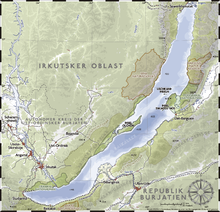Graticule
A graticule is used to clearly define points on a surface of revolution (e.g. sphere or ellipsoid )
The graticule on the globe
Similar to how a right-angled coordinate system can be defined in the plane , such a grid can also be defined on the spherical surface . This consists of:
- Circles of latitude : circles that run parallel to the equatorial plane of the sphere. One of them is the equator itself (a great circle ), the others lie parallel to it, shifted to the north and south and become smaller and smaller ( small circles of the sphere).
- Longitudinal circles : These all run from pole to pole. So all longitudes are great circles. They are also perpendicular to all circles of latitude.
Latitude and longitude are counted in degrees :
- Circles of latitude starting at zero degrees at the equator to the north and south (90 ° each). They are always 111 km apart per degree.
- Longitudes starting with a marked, arbitrarily determined prime meridian to the west and east (180 ° each). This way of counting is similar to the spherical coordinates commonly used in mathematics . It also has the advantage that it is independent of the radius of the sphere. Each point on the sphere is clearly defined by specifying the length and width .
The graticule on the map
The graticule of the globe can be shown on the flat map when creating a map . Depending on the map projection selected , a mesh of the graticule is displayed as a square, rectangle, trapezoid or sector of a circular ring.
Instead of the graticule, a different coordinate system can also be entered in maps as a grid and used for location information. So z. B. the so-called UTM grid ( MGRS ) used by the military .
